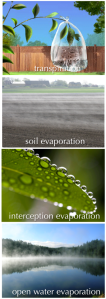Importance of evaporation
Evaporation is a major and important process that plays a critical role in both the water balance and the land surface energy balance. Worldwide 60-80% of the rainfall evaporates, making it the largest outgoing flux in the water balance and therefore of highest importance for hydrologic modelling, flood and drought risk assessments, climate change studies, and water resources management and planning. However, the technical challenges and costs of producing high resolution, accurate, and reliable data sets over various spatial scales implies that evaporation is not widely measured. Instead, actual evaporation is commonly estimated by hydrological modelling and remote sensing. Hydrological modelling, however, is not a very reliable way to estimate evaporation because hydrological rainfall-runoff models are relatively insensitive to the parameterization of evaporation when the model is calibrated on runoff only. When looking at other internal model states such as soil moisture, or groundwater, it is shown that rainfall runoff models are sensitive to evaporation inputs. Knowledge on evaporation is thus of utmost importance for model realism (‘getting the right answer for the right reason’). This becomes especially critical for hydrological systems in a changing world with a variety of anthropogenic influences.
and the land surface energy balance. Worldwide 60-80% of the rainfall evaporates, making it the largest outgoing flux in the water balance and therefore of highest importance for hydrologic modelling, flood and drought risk assessments, climate change studies, and water resources management and planning. However, the technical challenges and costs of producing high resolution, accurate, and reliable data sets over various spatial scales implies that evaporation is not widely measured. Instead, actual evaporation is commonly estimated by hydrological modelling and remote sensing. Hydrological modelling, however, is not a very reliable way to estimate evaporation because hydrological rainfall-runoff models are relatively insensitive to the parameterization of evaporation when the model is calibrated on runoff only. When looking at other internal model states such as soil moisture, or groundwater, it is shown that rainfall runoff models are sensitive to evaporation inputs. Knowledge on evaporation is thus of utmost importance for model realism (‘getting the right answer for the right reason’). This becomes especially critical for hydrological systems in a changing world with a variety of anthropogenic influences.
To better understand evaporation my research focuses on two major challenges that have to be tackled: 1) accurately quantifying actual evaporation by observations in different land use settings; 2) defining how total evaporation is partitioned into separate evaporation components, i.e., interception, soil evaporation, and transpiration.
- Quantifying actual evaporation; Despite the importance of evaporation, not many observation stations exist. Worldwide there exist over 67,000 rain gauge stations and 9,000 runoff stations, against only 439 evaporation flux towers. This limited number of measuring points results in a limited understanding of evaporation. Especially, considering the large diversity in land use settings like forests, agriculture, pastures, and urban areas. Existing techniques to measure evaporation, like eddy correlation systems or scintillometers, are expensive and more importantly not always applicable in all land use settings due to footprint issues, non-closure of the energy balance, heterogenetic surfaces, sensor sensitivity, and required non-trivial correction factors.
- Evaporation partitioning; Knowledge on how total evaporation is partitioned into productive (transpiration) and non-productive evaporation (interception, soil, and open water evaporation) is of highest importance for water management practices, irrigation scheme design, and climate modelling. Especially for modelling purposes, this information is crucial due to differences in time scales of the different evaporation components (e.g., transpiration is a monthly process and interception a daily). If observations of total evaporation are already limited (point 1), observations on the separated evaporation processes are even scarcer. And when available, observations are often highly uncertain, due to measuring difficulties such as instrument resolution, and underlying measuring assumptions. This causes the magnitude of the ratio of transpiration to total evaporation to still be under debate.
During my PhD study I focussed on quantifying interception evaporation (canopy and forest floor interception) and currently I focus on enhancing our understanding of evaporation. Therefore I will apply two different measuring techniques: ‘DTS‘ and ‘stable water isotopes‘. The first technique aims specifically at the quantification challenge [1], and the second technique at the partitioning challenge [2]. However, both techniques provide information on the other challenge as well. This allows me to benefit from the strength of each technique, and secondly, the results can be cross-verified.
This research is funded by a VENI from NWO Earth and Life Sciences (ALW).
